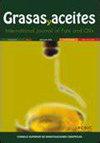猕猴油水解产物的提取及其在甲酯生产中的应用
IF 1.1
4区 农林科学
Q4 CHEMISTRY, APPLIED
引用次数: 0
摘要
本工作的目的是从马卡巴油的水解中获得富含游离脂肪酸(FFA)的水解产物,用于随后的酯化和获得甲酯。为了确定在水解步骤中使FFA产率最大化的条件,在55ºC和6小时下测定缓冲溶液百分比和催化剂浓度(Lipozyme®RM IM)的影响。从结果来看,验证了在实验范围内评估的两个变量都对反应有影响,并且它们的增加有利于FFA的产生。进行了额外的实验来评估反应时间的影响,反应时间逐渐增加至8小时。获得了约92 wt%FFA的水解物,并将其用于使用Novozym®435作为催化剂的酶促酯化步骤,导致约95%的FFA转化率。关于每个阶段酶的再利用,发现FFA产量降低了约50%,FFA转化率仅为98%。本文章由计算机程序翻译,如有差异,请以英文原文为准。
Obtaining hydrolysate from macauba oil and its application in the production of methyl esters
This work aimed to obtain a hydrolyzate rich in free fatty acids (FFA) from the hydrolysis of macauba oil for subsequent esterification and obtaining of methyl esters. To determine the conditions that maximize FFA yield in the hydrolysis step, the effects of buffer solution percentage and catalyst concentration (Lipozyme® RM IM) were determined at 55 ºC and 6 h. From the results, it was verified that both variables evaluated in the experimental range had an influence on the reaction and their increase favored the production of FFA. Additional experiments were carried out to assess the influence of reaction time with a progressive increase up to 8 h. Hydrolyzate with ~92 wt % FFA was obtained and its use in the enzymatic esterification step using Novozym® 435 as catalyst resulted in ~95 % FFA conversion. Regarding the reuse of enzymes at each stage, a ~50 % reduction in FFA yield was found and only 98 % FFA conversion.
求助全文
通过发布文献求助,成功后即可免费获取论文全文。
去求助
来源期刊

Grasas y Aceites
工程技术-食品科技
CiteScore
2.50
自引率
0.00%
发文量
50
审稿时长
3 months
期刊介绍:
Grasas y Aceites is a peer-reviewed journal devoted to the publication of original articles concerning the broad field of lipids, especially edible fats and oils from different origins, including non acyl lipids from microbial origin relevant to the food industry. It publishes full research articles, research notes, reviews as well as information on references, patents, and books.
Grasas y Aceites publishes original articles on basic or practical research, as well as review articles on lipid related topics in food science and technology, biology, (bio)chemistry, medical science, nutrition, (bio)technology, processing and engineering. Topics at the interface of basic research and applications are encouraged. Manuscripts related to by-products from the oil industry and the handling and treatment of the wastewaters are also welcomed.
Topics of special interest to Grasas y Aceites are:
-Lipid analysis, including sensory analysis
-Oleochemistry, including lipase modified lipids
-Biochemistry and molecular biology of lipids, including genetically modified oil crops and micro-organisms
-Lipids in health and disease, including functional foods and clinical studies
-Technical aspects of oil extraction and refining
-Processing and storage of oleaginous fruit, especially olive pickling
-Agricultural practices in oil crops, when affecting oil yield or quality
 求助内容:
求助内容: 应助结果提醒方式:
应助结果提醒方式:


